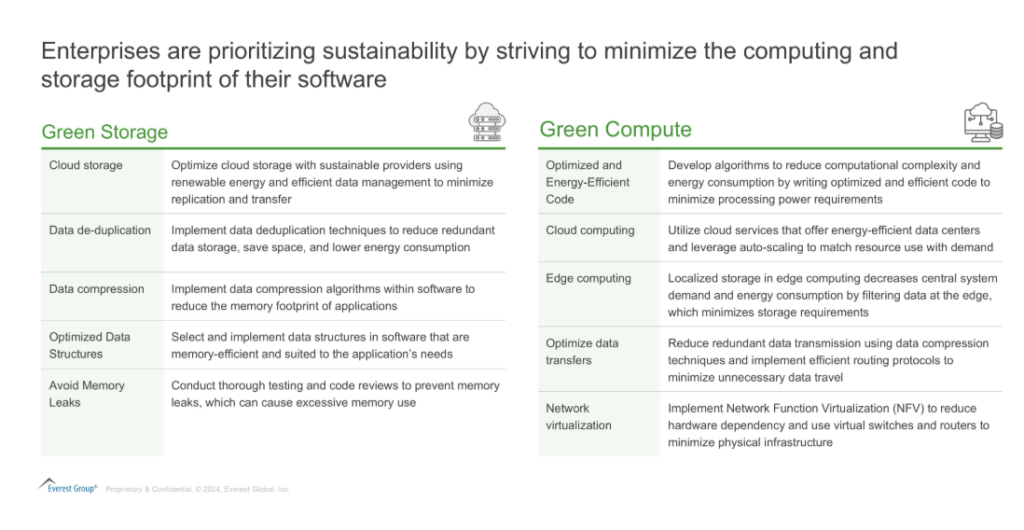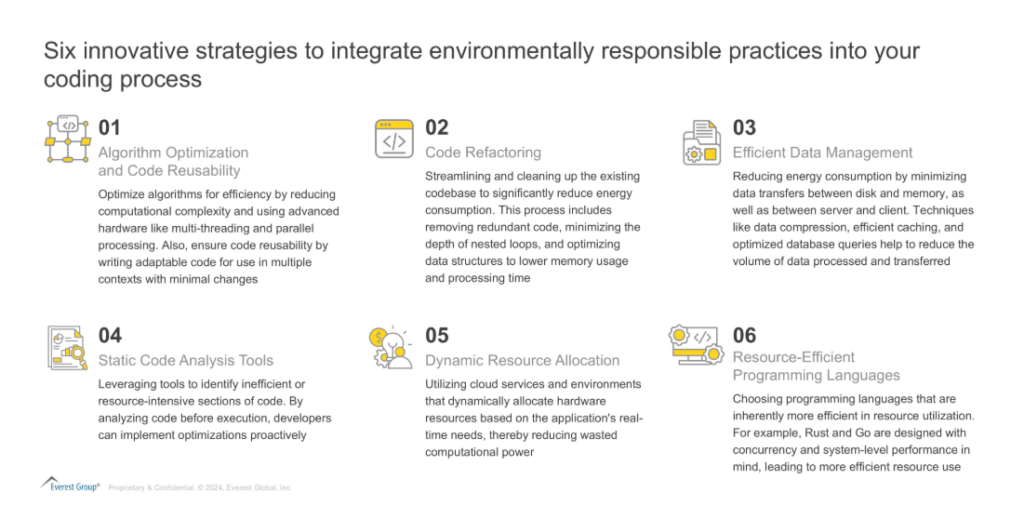Blog
Driving Sustainability with Green Software Engineering

As the world becomes increasingly aware of environmental issues, sustainability in software development has emerged as a critical area of focus. While traditionally associated with physical products and processes, sustainability now extends to the digital realm, with the software sector playing a pivotal role in reducing carbon emissions.
The technology industry holds a unique position to drive this change. It is imperative for developers, businesses, and consumers to understand the environmental impact of software development and adopt greener practices.
Reach out to discuss this topic in depth.
How software affects sustainability
Sustainability in software was often overlooked, as many assumed it didn’t pose environmental challenges like hardware, however, this view has shifted. Inefficient development practices and the hardware demands driven by software significantly increase energy consumption and carbon emissions.
With the rise of cloud computing, edge technologies, and the Internet of Things (IoT), software’s environmental impact has grown. While innovations like serverless computing and containerization improves efficiency, they also contribute to higher energy usage and e-waste.
While most senior Information Technology (IT) decision-makers acknowledge Environmental, Social, and Governance (ESG)and sustainability as top priorities, many enterprises are still in the midst of their digital transformation journeys or have yet to begin. These organizations are heavily investing in digital initiatives but continue to struggle with technical debt.
Sustainability, however, offers a promising opportunity. It not only accelerates digitalization but also aligns seamlessly with enterprise-wide optimization efforts. As we move toward an information-driven economy that leverages data for smarter decisions, businesses have a unique chance to embed sustainability into their digital strategies, enhancing operational efficiency, while staying competitive.
A central focus of sustainability efforts is reducing the storage and computing footprint of software. By optimizing resource consumption, companies strive to lower energy usage and minimize the environmental impact of their digital operations.

Green software engineering – a step toward sustainability
Green software engineering is centered on building software with sustainability as its core principle. It aims to minimize the environmental impact of software by reducing energy usage, resource consumption, and carbon emissions across the software lifecycle.
Key features include:
-
- Optimized energy usage: Focuses on writing energy-efficient code, minimizing the energy consumed by software during execution. This includes using algorithms and approaches that reduce computational power and processing requirements
- Reduced resource consumption: Designs software to use fewer hardware resources (Central Processing Unit (CPU), memory, storage) while maintaining optimal performance, promoting efficient resource utilization without over-provisioning
- Lowered environmental impact: Prioritizes reducing carbon emissions through the use of renewable energy-powered infrastructure, optimized data centers, and energy-efficient hardware. Leading companies like Google and Microsoft demonstrate these eco-friendly practices, showing the feasibility of greener software solutions.
Languages and frameworks like Go, Rust, and Node.js have gained significant popularity among developers in recent years, thanks to their focus on energy efficiency and sustainability. These technologies are designed to minimize resource consumption, making them more eco-friendly choices for modern software development.
To help developers make informed decisions, comparative benchmarks also allows them to evaluate the energy consumption of various technologies. This guides the selection of the most sustainable options based on specific project needs.
However, adopting these greener technologies comes with its challenges:
-
- System compatibility: Integrating new frameworks with existing systems can be complex
- Learning curve: Developers may need time to master these newer technologies, which may differ from traditional languages
- Performance trade-offs: Optimizing for sustainability can sometimes impact performance, requiring careful balance
Overcoming these challenges will require collaboration between developers, researchers, and industry stakeholders to find effective solutions that both reduce environmental impact and maintain high performance.

Challenges to adoption
Despite advancements in sustainable software engineering, several challenges hinder its widespread adoption, particularly among small and medium-sized enterprises (SMEs). The key barriers include:
-
- Limited awareness and resources: Many organizations, especially SMEs, lack the necessary awareness, expertise, and financial resources to prioritize sustainability in software development
- Complexity in measuring environmental impact: Evaluating energy consumption and emissions requires advanced lifecycle assessment tools and a deep understanding of hardware, cloud infrastructure, and software architecture
- Absence of standardized frameworks: The lack of universal standards creates inconsistencies, making it harder to ensure compliance with environmental regulations, measure impact, and achieve system interoperability
- Trade-offs between performance and sustainability: Optimizing for sustainability often involves balancing energy efficiency with performance and user experience, which can be challenging for developers
- Integration with existing systems: Embedding sustainability into current workflows and systems demands a significant mindset shift, along with technical adjustments and training to adopt newer, eco-friendly technologies
Opportunity for service providers
As enterprises increasingly prioritize sustainability, service providers have a unique opportunity to lead and support this transformation by delivering solutions that align with environmental goals while enhancing operational efficiency. Here are key areas where service providers can make a meaningful impact:
-
- Develop green software solutions: Create energy-efficient software applications that reduce carbon emissions and resource usage, meeting the growing demand for sustainable technology from environmentally conscious enterprises
- Provide consulting and integration services: Take proactive initiative with clients to embed sustainable software architectures, optimizing cloud resource usage, and embedding energy-efficient practices throughout the software development lifecycle
- Develop sophisticated lifecycle assessment tools: Offer artificial intelligence (AI)-enabled tools that enable comprehensive auditing and measurement of a software product’s environmental impact, assessing energy consumption, resource utilization, and carbon emissions throughout its entire lifecycle, from design to disposal
- Build training and certification programs: Develop specialized training modules and certifications to equip developers with expertise in green coding, carbon efficiency, and sustainable development practices
By focusing on these opportunities, service providers can differentiate themselves in a competitive market, drive innovation in sustainability, and position themselves as essential partners in achieving their clients’ ESG objectives.
If you found this blog interesting, check out our blog focusing on Getting Digital Product Verification And Validation Right Through “As-a-Service” Models | Blog – Everest Group, which delves deeper into another subject focused on by the Engineering & Information Tech service line.
We are actively tracking the evolution of sustainability and its impact on the future of all sectors. To discuss the latest trends and their implications for brands, technology vendors, and service providers alike, feel free to reach out to Manjul K ([email protected]), Mayank Maria ([email protected]) and Kishore BS ([email protected]).